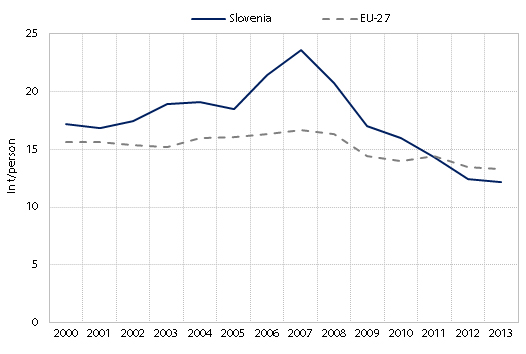ENVIRONMENTAL WELL-BEING - Non-energy sources
The indicator Domestic material consumption per person shows total weight of substances (biomass, metal ores, non-metallic minerals, fossil fuels, etc., excluding water and air) that enter into production and consumption in a country in relation to the total population. Because these substances are mostly non-renewable and thus limited in the nature, their use reduces their availability. As water, air and space, sustainable management of natural resources is the basis for society’s existence and functioning. Greater consumption of substances leads to more waste and emissions. Growth of the indicator has a negative impact on the well-being of existing generations, while reduction of resources has primarily a negative impact on the future generations.
Figure: Domestic material consumption, Slovenia and the EU, 2000−2013 (t/person)

Source of data: SURS, Eurostat.
In 2013, Slovenia consumed 12.15 tons of material per capita, which is only 2% less than a year earlier, but almost half less than in 2007, when consumption per capita was the highest. Influenced by the low economic activity in construction, the decline in recent years was largely caused by lower consumption of non-metallic minerals, which was the most important factor of large material consumption in 2007, when Slovenia exceeded the EU average by more than 40%. With a large decline in economic activity, particularly in the construction sector, domestic material consumption in Slovenia shrank more since the onset of the economic crisis, so that in 2011 Slovenia was below the EU average in terms of material consumption per person.
